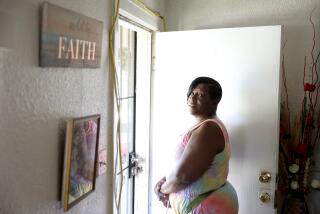Center to Treat Foster Children’s Mental Illnesses
- Share via
Stepping into a controversial new arena for treating emotionally disturbed foster children, a prominent child welfare agency on Thursday broke ground for a comprehensive residential treatment center.
The $3.2-million home for mentally ill children and teenagers who have failed in other types of group homes and foster-family settings and will be California’s first such facility.
Its operator, nonprofit Vista del Mar Child and Family Services of West Los Angeles, will spend another $1.5 million a year running the 24-patient treatment center.
Under new state rules, youngsters in such facilities can be locked up if necessary--a policy that has stirred great debate. Critics of “securable” facilities have complained that youngsters might be warehoused with little or no treatment.
In past years, as state hospitals have closed and private psychiatric facilities have often limited stays to only a few days, parents and child welfare officials have been forced to send severely troubled youngsters to residential treatment facilities in Arizona, Utah, Texas, Oregon and elsewhere, where lockups are allowed. The Vista del Mar treatment center will feature securable residential wings connected to classrooms, a recreation area, a medical center and a treatment unit that will offer “intense therapeutic support” for patients ages 6 through 16.
“People have commented to me, ‘I can’t believe you’re taking this kind of risk,’ ” acknowledged Gerald Zaslaw, Vista del Mar’s president. “We don’t have to do this. We have a waiting list as it is for our present facilities. But there are kids we have had to give up on in the past that won’t have to now.”
Eighty-eight youngsters who have been abused or neglected currently live at Vista del Mar. The 90-year-old agency also operates an elementary school for emotionally disturbed and developmentally delayed children, a state-licensed nonpublic school for older students, a private adoption agency and a foster care program.
Zaslaw said youngsters who are successful at the new therapeutic treatment center will graduate to Vista del Mar’s regular program. They will also have use of existing recreational facilities at the 17-acre Motor Avenue site.
Placement at the center will come from referrals from mental health and child and family services officials--not from the juvenile probation department. Officials expect that parents’ private insurance and government reimbursements will cover the estimated $375-per-day cost of treatment, Zaslaw said.
Plans for the new center were praised Thursday by child welfare experts in Washington and at the West Los Angeles site. There, about 150 people gathered for a groundbreaking ceremony and to salute Beverly Hills developer Stanley Black, whose family donated $1 million to the project.
In Washington, the head of a national family services organization noted that in the past the only access that some children have had to mental health treatment has been through the corrections system.
“That’s outrageous,” said David Liederman, executive director of the Child Welfare League of America. “The fact that Vista del Mar is taking the lead out there is encouraging.”
Peter Digre, director of the Los Angeles County Department of Children and Family Services, said there is no shortage of youngsters who might benefit from the new center.
“They are kids we frankly don’t take very good care of,” Digre said. “These few hundred tragic kids kind of float around our system. They are our most troubled kids, kids with the most hurts, the most rejection.”
Digre characterized Vista del Mar and its project as the “absolute flagship” of children’s support services in the county, which lists 55 such agencies.
Thursday’s ceremony also helped mark Vista del Mar’s 90th anniversary. It began in 1908 in Huntington Park as the Jewish Orphans Home of Southern California.
Joe Orloff, an 89-year-old retired lawyer, lived in the home between 1913 and 1917. He said he is not surprised how the orphanage evolved.
“The population has gotten larger, technology has grown and there are more problems in the world,” Orloff said.
“This place has grown, too.”
More to Read
Sign up for Essential California
The most important California stories and recommendations in your inbox every morning.
You may occasionally receive promotional content from the Los Angeles Times.














